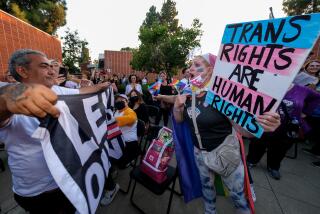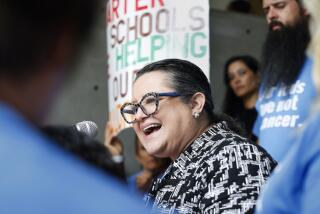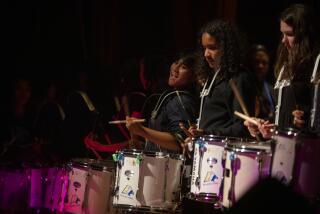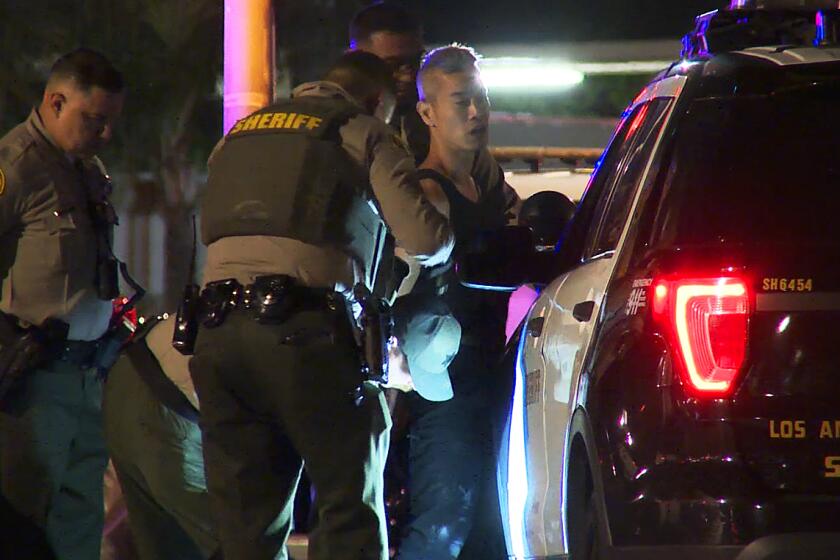Contentious George Washington mural at San Francisco school can stay, judge decides

San Francisco Unified School District broke the law when it voted to cover up a contentious mural at George Washington High School without first examining the environmental impacts, a judge ruled this week in a win for the high school alumni association suing over the issue.
Judge Anne-Christine Massullo’s decision culminated a debate over two years in the making about the fate of the mural, “Life of Washington,” which depicts enslaved Black people as well as the body of a dead Native American surrounded by white settlers.
The judge’s order means the mural, which has remained untouched for the last two years of litigation, can stay — for now.
The alumni association has “put forward many ideas about what should happen to make these magnificent murals a teaching tool and use them in a positive way, which they’ll no doubt continue to promote,” said the association’s attorney, Susan Brandt-Hawley.
“They wanted the murals to have the protections of state environmental law, and now the court’s ruling has assured that ... the process that the murals deserve will happen, so they’re delighted with that.”
The alumni association sued the school district in 2019, contending it did not comply with the California Environmental Quality Act when it voted to cover New Deal artist Victor Arnautoff’s 1,600-square-foot art installation. The district should have completed an environmental impact report, the association alleged. The judge agreed in a 42-page, sometimes strongly worded order.
“Political actors at every level are tempted to circumvent what they consider to be inconvenient legal requirements in order to advance parochial political agendas,” Massullo wrote. “The hallmark of our system is that whether it concerns the president of the United States or a local school board, the rule of law — the process — is more important than the result.”
If the school district decides to move forward with covering the mural, Brandt-Hawley said the San Francisco Board of Education must first set aside its previous votes and agree to do an environmental impact report.
“We are certainly hoping they will decide not to proceed,” she said.
School district representatives did not respond to multiple requests for comment.
The board of education’s 2019 decision to cover the mural followed months of meetings, the convening of a special committee to review the issue, more than 13,000 signatures on a “save the historic murals” petition and hours of public debate.
The massive mural is made up of 13 panels portraying various stages of the first president’s life. In one scene at the heart of the contention, Washington is at Mount Vernon, where enslaved Black Americans toil in the fields. In another, Washington and other Founding Fathers and settlers are standing over a Native American, apparently dead, lying facedown. Other scenes show Washington speaking to a group of men, leading soldiers and discussing the Constitution.
“The murals are a realistic portrayal of Washington’s life and times and must be protected for the benefit of current students and future generations,” John Rothmann, the alumni association president, said in a statement.
Arnatuoff was one of several New Deal-era artists federally commissioned to paint murals on institutions countrywide. He created the George Washington High School work al fresco, a permanent fixture of the school’s stairway and lobby entrance.
Debates over the mural date to 1968, when Black, Asian and Chicano students protested the demeaning portrayals of Black and Native Americans, according to the court order.
Some scholars have argued that Arnautoff’s work was subversive, intended to disrupt traditional ideas of Washington and other American heroes by juxtaposing them with those they oppressed. At public meetings, several people said keeping the mural would be an opportunity to educate the public on America’s history.
But for other students and members of the school community, the mural is offensive and racist.
“I understand the importance of art, and it should be the last thing we do, to attempt to cover any kind of art up,” board of education Commissioner Mark Sanchez said at the time, when he was vice president. “The starting point has to be from those who feel they are harmed and how that is unacceptable, especially given the history of this country. When we don’t listen, we don’t learn.”
Sanchez has since led the effort to change 42 of the district’s school names — including George Washington High School — for connections to white supremacy, colonization, slavery and oppression. The board suspended that controversial effort in April after months of national discussion.
More to Read
Start your day right
Sign up for Essential California for news, features and recommendations from the L.A. Times and beyond in your inbox six days a week.
You may occasionally receive promotional content from the Los Angeles Times.







